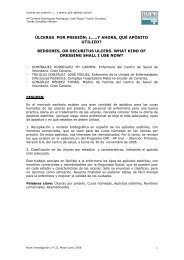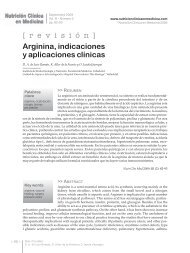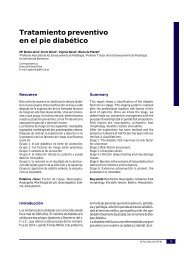OPEN SURGERY FOR REVASCULARIZATION OF THE DIABETIC FOOD ■ 87Pulli et al. (33) in a multicenter registryreported midterm results of infrainguinalbypasses performed in 425 patients presentingwith CLI (56% of a BK bypass and 24% ofa AK bypass). Cumulative estimated 36-monthprimary patency, secondary patency, limb salvage,and survival rates were respectively61%, 70%, 83%, and 83%. The factors associatedwith poorer limb salvage rates were thepresence of ischemic ulcers or gangrene (P.004), and the presence of only one patent tibialvessel (P < .001).Overall, these results, though not obtainedin a randomized controlled trial, provide solidadditional evidence that heparin-bonded ePTFEgrafts represent an important new option inthe treatment of peripheral arterial disease.PECULIAR TECHNICAL ARTIFICESAritifices for distal anastomosisFailure of PTFE bypass grafts to the BKlevel is thought to be a result of neointimalhyperplasia at the distal anastomosis. O<strong>net</strong>heory to account for these processes is acompliance mismatch between the prostheticmaterial and the native artery.Several adjunctive techniques have beendesigned to improve the patency rates ofprosthetic bypass grafts. These techniquesinclude the construction of a vein patch orcuff at the distal anastomosis to preventocclusion by intimal hyperplasia, and the crea -tion of a distal arteriovenous fistula (AVF) toincrease graft blood flow in high outflowresistance systems (34).A randomized prospective study with theuse of a distal anastomosis interposition veincuff, reported 2-year cumulative patency ratesof 62% for femoro-infrapopliteal grafts (35).At the BK site, this was reflected in 24-month difference in limb salvage rates of 84%vs. 62%, respectively (P .08), with a statisticallysignificant advantage when PTFE bypass graftswere anastomosed to the BK popliteal artery.Distaflo PTFE is an alternative PTFE prosthesisthat mimics a vein cuff.Pan<strong>net</strong>on et al. (36) in a multicenter randomizedprospective trial compared theresults of this pre-cuffed PTFE graft to a veincuffed graft. Bypass was a redo procedure in53% and was performed at the infrapoplitealvessels in 79%. At 1 and 2 years, primarypatency was 52% and 49% for the precuffedgroup and 62% and 44% for the vein cuffedgroup, respectively (P .53). Then the Authorsconcluded that this precuffed graft is a reasonablealternative conduit in place of thevein cuff.Vein interposition AVF proposed by Ascerhas represented an alternative method combiningsome of the aforementioned principles(37). This technique matches the use of aPTFE graft with a distal AVF and vein interpositionat the distal anastomosis, resulting incontinued prograde flow in the target arterydistal to the fistula. By this method the Authorreported a primary patency at 3 years of 65%,and 78% of limb salvage, respectively.In this series the distal arterial targetswere frequently the tibial vessels, and thistechnique was frequently used as redo procedure.We reported a similar experience with3-year cumulative patency rates of 62% and alimb salvage of 66%, respectively (38).Another possible artifice to improve theflow of distal anastomosis was described bySogaro et al. (39) that confectioned an adjunctivearteriovenous fistula by pantaloon technique.Secondary cumulative patency at 57months was 57.3% with a 61.5% limb salvagerate.Artifices for the passage of the graftSeveral aspects influence the patency of adistal bypass grafts. The passage of the graftsshould be performed far from cutaneous scar,in a deep position, eliminating structures thatcould compress the graft.The more frequent target of a distal revascularizationfor the treatment of extensivetissue loss or gangrene is represented by thedorsalis pedis artery. Approaching this arterythe extensor digitorum longus tendon shouldbe partially resect to avoid the external com-
88 ■ PIE DIABÉTICOpression of a venous bypass (total resectionshould be performed in case of completeantefoot gangrene). The passage of the graftshould be preferentially performed throughthe interosseus membrane opening a largedoor on this membrane and mobilizing a longtract of the distal arterialized vein. Also theflexor digitorum longus tendon and thesoleus aponeurosis should be resect to avoidthe compression of the vein before the passagethrough the interosseus membrane.Artifices for clampingActually, the use of ordinary clamps canresult in arterial damage, especially in endstage renal disease (ESRD) patients affectedby critical limb ischemia (CLI).The majority of patients with advancedperipheral arterial disease had a very diseaseddistal arterial <strong>net</strong>work with heavily calcifiedarteries, poor run-off, and relevant comorbidities.Consequently, bypasses were moredistal and technically demanding if comparedto the standard CLI patients.Principally in patients with end stage renaldisease the distal arteries are not compressibledue to extensive wall calcification.For several years, by performing distalanastomosis, we have been putting a clamponly on the proximal part of the target vesseland we have been applying, as Ysa et al (40), anintravenous cannula in order to occlude thedistal end of the arteriotomy in tibial andplantar vessels (41).We connected the cannula by a 20-cmlong plastic tube to a 30-mL syringe filled withheparinated (.20%) saline. The length of thetube has been useful to not hinder the suturingmaneuvers. The whole system allowed aregular flushing with heparinated saline intothe distal runoff, preventing thrombosis of thelumen in cases of poor retrograde bleeding.The size of cannulas varied according to thelumen of the artery.Despite the caliber adaptation, in few casesit was not possible to move the cannula forwardinto the artery. In these situations, wechoose to clamp the artery only proximally toFig. 1. No clamping technique for distal anastomosisat the dorsalis pedis artery.the arteriotomy and not to clamp it distally(Fig.1). In order to minimize blood loss, wepositioned the patient in an extremeTrendelenburg position, and we clamped thedistal artery by gentle external digital compression,flushing the anastomosis area bypouring saline that flowed away with the bloodthanks to the upraised position of the limb.This artifice critically improves the techniquereducing the arterial trauma in calcifiedand diseased arteries.ALLOGRAFT AND XENOGRAFTTransplantation of a vascular allograft is anattractive alternative in patients with nosuitable autologous vein.The ideal vascular allograft should have ahigh graft patency rate, a low graft disintegrationrate, should be available off the shelf indifferent diameters and lengths, and be able tobe stored for long periods.Fahner et al. (42) in a systematic reviewevaluated the results of clinical studies inwhich vascular allograft were used in themanagement of patients needing an infrainguinalbypass operation for a total of 3837allograft found. The patency and then the limbloss were directly correlated to type ofpreservation. One-year cumulative primarypatency rates were 13% to 79% for cryopreservation,63% to 80% for cold storage, and
















